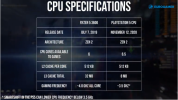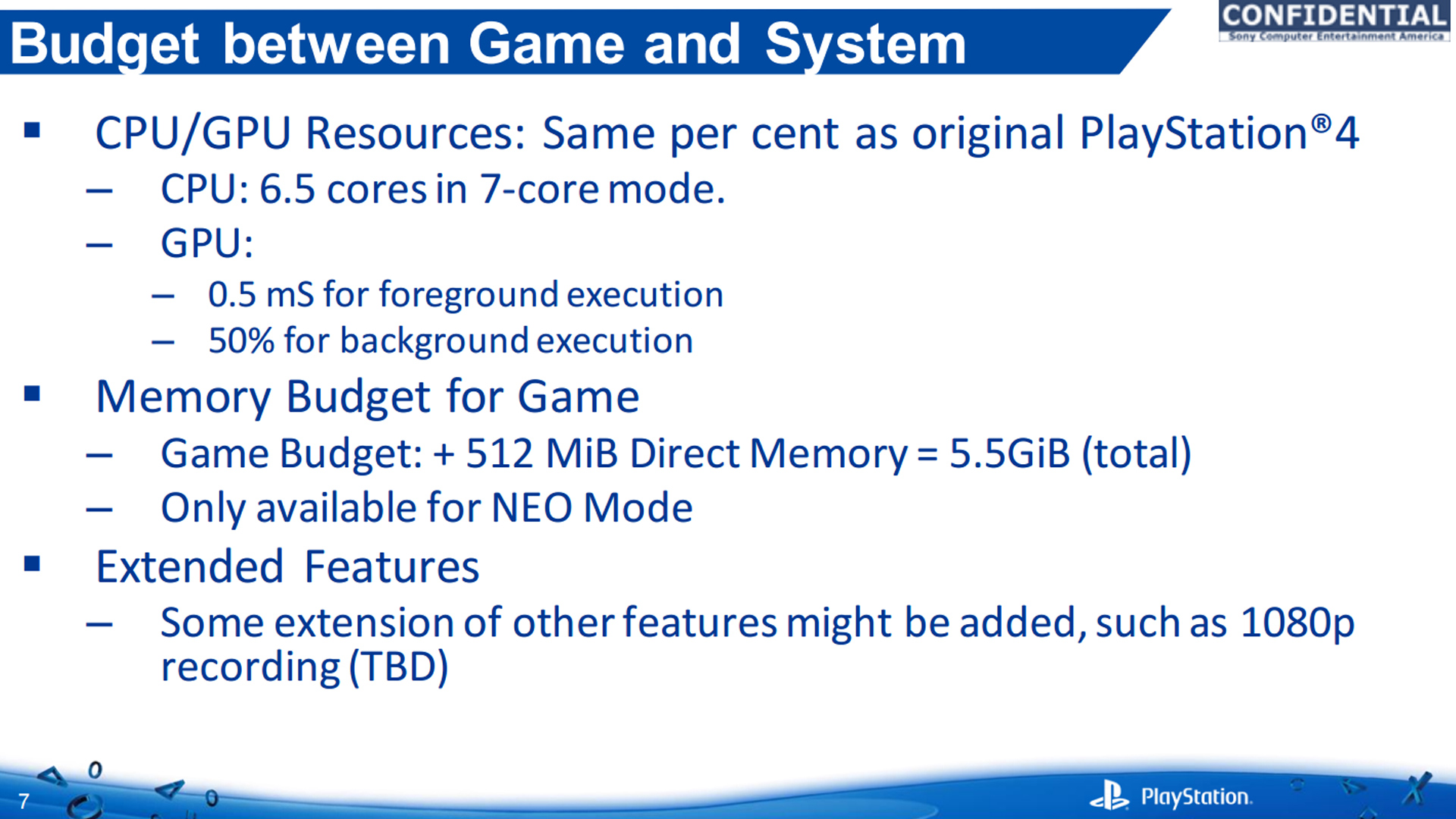What are the current system reservations on current-gen systems such as PS4, PS 4Pro, and Xbox One S, XBox One X?
I seem to have misplaced my SDKs and searching/googling is drawing hits from pre-launch 2013, so I'm hoping the community can help out with this question.
I'm looking for things like the 20% to 50% of the 7th CPU Core and 100% of the 8th CPU core and time-sliced 2% of all GPU CUs is reserved for OS/Dashboard use. These may not be accurate numbers, but I wanted to show what info I'm looking for.
If you can also list initial reservations and how they changed over time, you'll get bonus likes.
Thank you,
---
Current-Gen Reservations
Xbox One
Around early 2014 Microsoft changed System Reservation from time-sliced 10% GPU to 2% GPU. The initial 10% was broken down to 2% for Voice and 8% for Video, giving developers use of 98% of GPU.
Around late 2014 Microsoft changed System Reservation from 100% CPU Core #7 to allow for using only 20% to 50% of CPU Core #7, giving developers use of 80% to 50% of CPU Core #7.
PS4
Around late 2015 Sony changed System Reservations from 100% CPU Core #7 to allow for using only 50% of CPU Core #7 or 60% of CPU Core #7 if VR, giving developers use of 50% of CPU Core #7 or 40% of CPU Core #7 if VR.
---
Next-Gen Reservations
Xbox Series X:
1 CPU core (or 2 threads) reserved for OS/Dashboard
Games can use SMT or not; 8 physical cores at 3.8 GHz (SMT disabled), or 16 cores and threads at 3.6 GHz (SMT enabled)
The OS/Dashboard reserves 2.5GB GDDR6 memory from the 336 GB/s memory pool and 32 Meg from the 560 GB/s pool.
[ Sources: https://www.eurogamer.net/articles/digitalfoundry-2020-inside-xbox-series-x-full-specs ]
Series S:
1 CPU core (or 2 threads) reserved for OS/Dashboard
Games can use SMT or not; 8 physical cores at 3.6 GHz (SMT disabled), or 16 cores and threads at 3.4 GHz (SMT enabled)
The OS/Dashboard reserves 2 GB GDDR6 memory from the 56 GB/s memory pool and 16-32 Meg from the 224 GB/s pool.
[ Sources: https://www.eurogamer.net/digitalfo...-memory-boost-and-the-massively-fast-rtx-4090 ]
PlayStation 5:
1.5 Cores (out of 8) reserved for OS/Dashboard
The physical cores run at 3.5 GHz or lower as SmartShift adapts.
The OS/Dashboard reserves 3.5GB memory.

[ Sources: DF Gotham Knights PC video]
I seem to have misplaced my SDKs and searching/googling is drawing hits from pre-launch 2013, so I'm hoping the community can help out with this question.
I'm looking for things like the 20% to 50% of the 7th CPU Core and 100% of the 8th CPU core and time-sliced 2% of all GPU CUs is reserved for OS/Dashboard use. These may not be accurate numbers, but I wanted to show what info I'm looking for.
If you can also list initial reservations and how they changed over time, you'll get bonus likes.
Thank you,
---
Current-Gen Reservations
Xbox One
Around early 2014 Microsoft changed System Reservation from time-sliced 10% GPU to 2% GPU. The initial 10% was broken down to 2% for Voice and 8% for Video, giving developers use of 98% of GPU.
Around late 2014 Microsoft changed System Reservation from 100% CPU Core #7 to allow for using only 20% to 50% of CPU Core #7, giving developers use of 80% to 50% of CPU Core #7.
PS4
Around late 2015 Sony changed System Reservations from 100% CPU Core #7 to allow for using only 50% of CPU Core #7 or 60% of CPU Core #7 if VR, giving developers use of 50% of CPU Core #7 or 40% of CPU Core #7 if VR.
---
Next-Gen Reservations
Xbox Series X:
1 CPU core (or 2 threads) reserved for OS/Dashboard
Games can use SMT or not; 8 physical cores at 3.8 GHz (SMT disabled), or 16 cores and threads at 3.6 GHz (SMT enabled)
The OS/Dashboard reserves 2.5GB GDDR6 memory from the 336 GB/s memory pool and 32 Meg from the 560 GB/s pool.
In terms of how the memory is allocated, games get a total of 13.5GB in total, which encompasses all 10GB of GPU optimal memory and 3.5GB of standard memory. This leaves 2.5GB of GDDR6 memory from the slower pool for the operating system and the front-end shell. From Microsoft's perspective, it is still a unified memory system, even if performance can vary. "In conversations with developers, it's typically easy for games to more than fill up their standard memory quota with CPU, audio data, stack data, and executable data, script data, and developers like such a trade-off when it gives them more potential bandwidth," says Goossen.
[ Sources: https://www.eurogamer.net/articles/digitalfoundry-2020-inside-xbox-series-x-full-specs ]
Series S:
1 CPU core (or 2 threads) reserved for OS/Dashboard
Games can use SMT or not; 8 physical cores at 3.6 GHz (SMT disabled), or 16 cores and threads at 3.4 GHz (SMT enabled)
The OS/Dashboard reserves 2 GB GDDR6 memory from the 56 GB/s memory pool and 16-32 Meg from the 224 GB/s pool.
Why are developers being told that it's 'hundreds of megabytes' more memory and not a more concrete figure? Since recording the Direct, I've discovered that the amount of memory is somewhat fluid. There's a block of new memory available to all developers, but this can be augmented by disabling system level features the game may not be using, freeing up extra memory that otherwise wouldn't be used anyway.
[ Sources: https://www.eurogamer.net/digitalfo...-memory-boost-and-the-massively-fast-rtx-4090 ]
PlayStation 5:
1.5 Cores (out of 8) reserved for OS/Dashboard
The physical cores run at 3.5 GHz or lower as SmartShift adapts.
The OS/Dashboard reserves 3.5GB memory.
[ Sources: https://www.eurogamer.net/digitalfo...-memory-boost-and-the-massively-fast-rtx-4090 ]As a counterpoint, I suggest that with 12.5GB of RAM available to developers on PS5 (at least at launch - and it's 13.5GB on Xbox)

[ Sources: DF Gotham Knights PC video]

